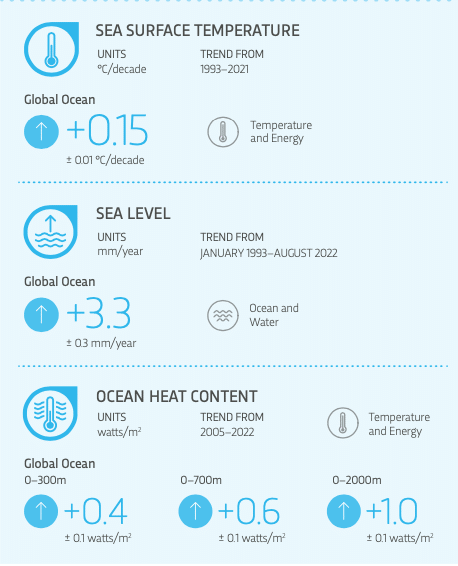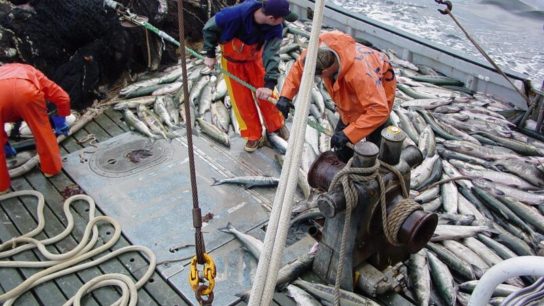The recently released Copernicus Ocean State Report 7 (OSR7) unveiled a comprehensive analysis of the world’s oceans, shedding light on how rising ocean temperatures are influencing climate patterns and marine life.
—
Anthropogenic climate change is leading to a concerning rise in ocean temperatures and water levels, which is causing far-reaching consequences for marine life and weather systems, a new report has found.
Published by Mercator Ocean International under the EU-funded Copernicus Marine Service, the seventh edition of the Ocean State Report (OSR 7) offers a multidimensional analysis of the current conditions as well as natural and anthropogenic changes in the European regional seas and the world’s oceans, covering aspects such as temperature, currents, biodiversity, and more.
Through satellite and in situ observation, ocean reanalyses, and high-performance computing that enabled 4D observations of the ocean, the nearly 100 scientific experts who worked on the report were able to identify various “unusual” patterns across the world’s ocean systems, including changes in circulation currents, more frequent and intense marine heatwaves, and unexpected events in biological production.
The report found that marine heatwaves, defined as a period of abnormally high water temperatures lasting at least five consecutive days, have become more frequent and intense both in the European regional seas and the global ocean with the exception of the Southern Ocean. At the same time, scientists observed a downward trend in the frequency and intensity of marine cold spells.
In April 2023, the global sea surface temperature reached 21.1C, surpassing the previous record of 21C in 2016. According to the report, large areas of the global ocean – particularly the tropical Atlantic and Pacific as well as the eastern subtropical North Atlantic – experienced repeated heatwave events of various intensity throughout the summer months. In the north-east Atlantic, experts observed a decrease of 50-60% in phytoplankton concentrations, which form the basis of the marine food web, as a result of increased marine heatwaves.

In August 2023, the Mediterranean Sea’s surface temperature hit 28.7C (83.7F), the highest median recording since at least 1982. The Mediterranean Sea – one of the world’s most diverse habitats for marine life, home to more than 17,000 species – is warming 20% faster than the global average – adding pressure to already strained ecosystems. In 2021, the WWF suggested that the Mediterranean is becoming the “fastest-warming and the saltiest sea on our planet.”
Rising sea surface and subsurface temperatures can have serious implications for marine species, such as coral reefs, kelp, and fish, often resulting in mass die-offs and migrations that inevitably lead to lower catch amounts and increased pressure on the fishing industry.
Rising marine temperatures also lead to a rise in sea level in a phenomenon known as thermal expansion that has been occurring at a steady rate for decades and accounts for nearly 75% of the sea level rise that occurred over the course of the 20th century. They also impact the salinity and freshwater levels in the oceans, altering oceanic circulation, currents, and water cycles.
These events had severe repercussions in Antarctica, too. In May and June 2023, the region recorded the lowest levels of sea ice extent since monitoring began. In June alone, nearly 2.20 million square kilometres (850 square miles) of sea ice, seven times the size of Poland, were lost.
More on the topic: World Records Hottest June in History Amid Historic Heatwaves and Extreme Ocean Temperatures
In a report published in May 2023, Australian scientists warned that the rapidly melting Antarctic ice will cause a slowdown of global deep ocean currents by mid-century, leading to the acceleration of sea level rise and changes in the world’s climate that will be felt for centuries.
The Meridional Overturning Circulation of oceans is a component of ocean circulation driven by the movement of colder, denser water toward the seafloor near Antarctica that helps deliver heat, carbon, oxygen, and vital nutrients across the globe. But as freshwater from the ice cap melts, sea water’s salinity and density decrease, slowing the downward movement. The collapse of ocean circulation, experts say, will have devastating consequences and long-term impacts on weather patterns, sea levels, and marine ecosystems and it will permanently affect the ocean’s ability to absorb carbon dioxide.
Aside from affecting the ocean, changes in marine currents can have severe effects on surface temperatures and climate, too. According to a study published in June 2023, the Atlantic meridional overturning circulation (AMOC), one of the most important tipping points in Earth’s climate system, could collapse around mid-century under the current emissions scenario.
AMOC is a large system of ocean currents driven by differences in the density of water, which determines their temperature. It acts as a conveyor belt, redistributing heat throughout the Earth’s climate system by bringing it from the tropics in the Southern Hemisphere all the way to Greenland and carrying cold water back south.
The freshwater input from glaciers’ melting, however, significantly weakens these currents. While the flow has already been reduced by about 15% in the last five decades, a weakening of 24% to 39% is expected even before the tipping point is reached, something that could happen, as the new study suggests, as early as in 2050. A study published in 2021 found that AMOC is already at its weakest in over 1,600 years.
“A slowdown of the AMOC could have consequences around the world,” the Intergovernmental Panel on Climate Change (IPCC) explains. “Rainfall in the Sahel region could reduce, hampering crop production; the summer monsoon in Asia could weaken; regional SLR [sea level rise] could increase around the Atlantic, and there might be more winter storms in Europe.”
The publication of the OSR 7 marks a milestone in our understanding of the world’s oceans, underscoring the urgency of taking action to protect and restore these vital ecosystems. As we navigate a changing climate and increasing environmental challenges, the insights provided by the report pave the way for informed decision-making and the adoption of effective measures to safeguard the health and resilience of our oceans.
You might also like: No Quick Fix to Reverse Antarctic Sea Ice Loss, Scientists Say As Continent Records Minimum Cover Since 1978


















